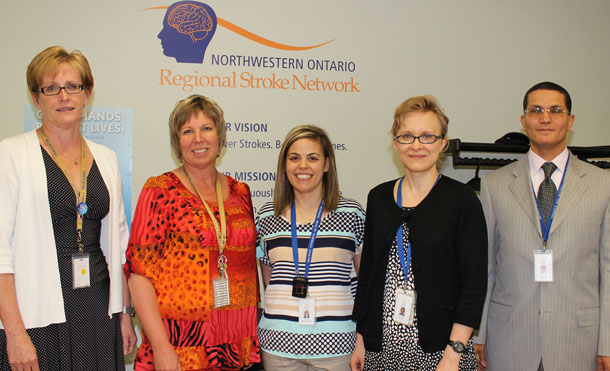

THUNDER BAY – Healthbeat – Secondary Stroke Prevention care at Thunder Bay Regional Health Sciences Centre (TBRHSC) through the Northwestern Ontario Regional Stroke Network was highlighted in a first-ever audit of Ontario’s 40 Secondary Stroke Prevention Clinics released at the end of June.
Stroke Prevention Clinics (SPCs) provide coordinated outpatient programs for people identified as being at high risk for stroke or transient ischemic attack (TIA) or who have recently had one. The clinic reviews the cause(s) of the stroke or TIA and assists with strategies to prevent reoccurrence.
Secondary stroke prevention is essential to reducing the risk of recurring vascular events in patients with prior stroke or (TIA). It is estimated that one in two strokes is potentially preventable and aggressive risk factor reduction, including more widespread use of blood pressure, cholesterol, anti-thrombotic/anti-platelet medication, has been credited with significant reductions in stroke incidence on a population level.
The regional SPC team of the Northwestern Ontario Regional Stroke Network at TBRHSC includes a secretary, Nurse Practitioner, three Neurologists, and a Dietitian. It provides additional funding to four community SPCs in Marathon, Fort Frances, Sioux Lookout, and Kenora, which are designed to follow up patients who have received care at TBRHSC. Individuals may be referred by an Emergency doctor, family doctor, specialist or nurse practitioner.
“Our interdisciplinary stroke team at TBRHSC is committed to providing excellent, evidence-based and patient-centred care for the people of Northwestern Ontario,” says Dr. Mark Henderson, Executive Vice President, Chronic Disease Prevention and Management.
The Report Card completed by the Ontario Stroke Network demonstrated several notable improvements in overall care and patient outcomes in Ontario, as well as opportunities for improvement, particularly with respect to timely access to SPCs for urgent cases.
The North West Local Health Integration Network (NW LHIN) was featured throughout the Report in specific examples of a region where efforts have resulted in significant improvements. Of the five spotlighted indicators measured in the report card, the NW LHIN excelled in the number of referrals initiated from the Emergency Department (ED), as well as completing cognitive screening. TBRHSC also scored high in completing required diagnostic tests prior to the first SPC visit and prescribing medications for preventing stroke related to atrial fibrillation.
Working with the ED to ensure patients are referred to the clinic for diagnostic tests and medications is critical because increasing evidence shows that an individual who experiences a minor stroke or TIA is at a high risk of a more serious stroke, death or other cardiovascular events. For individuals with certain risk factors, the seven-day risk of stroke following a TIA can be as high as 36%.
Another spotlight featured smoking cessation initiatives at the TBRHSC SPC. The nurse practitioner is certified in Training Enhancement in Applied Cessation Counselling and Health (TEACH), a specialized smoking cessation training program, and uses a carbon monoxide meter to quantify improvements in lung function for patients who have quit smoking. A new initiative being implemented will include smoking cessation counselling and support for inpatients and outpatients.
“We welcome this evaluation report, not only for pointing out areas of excellence,” says Caterina Kmill, Director of the Regional Stroke Program. “But it also identifies opportunities for further improvement in order to, ultimately, help us reduce the number of strokes through prevention and improve outcomes for those who do experience a stroke.”
For more information about the NW Regional Stroke Network visit http://www.tbh.net/clinical_partners/regional_stroke_program.













